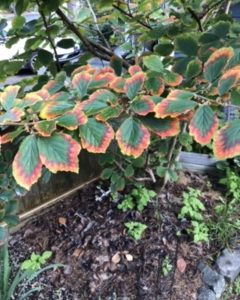
I feel fortunate that we live in a place where there is a definite changing of the seasons. As the summer days dwindle and the chilly air becomes the norm we are reminded that winter is on the way.
For the children, the marking of the seasons is a time of observation and a natural opportunity to learn about nature and animals.
In our play yard, which we visit up to 3 times per day, we can easily see signs of Fall and now, as we approach winter we can observe how nature prepares. We have a variety of trees and plants that are getting ready to “go to sleep” for the winter. Leaves changing and dropping to the ground. These leafs have been inspected, collected and admired by all the children in the past few weeks as natures transformation takes place.
We have witch hazel tree, which I have to say, if a wonderful example of fall!


We have also talked about the weather becoming colder, how plans and animals get ready for the winter.
How humans need to also prepare, warmer coats, mittens, hats. How it gets darker earlier and earlier, until the Winter solstice where light begins to return and the days become longer.
Following the childrens natural curiosity about seasons, nature, and animals can help foster their love for this planet and their place and time in our world.












